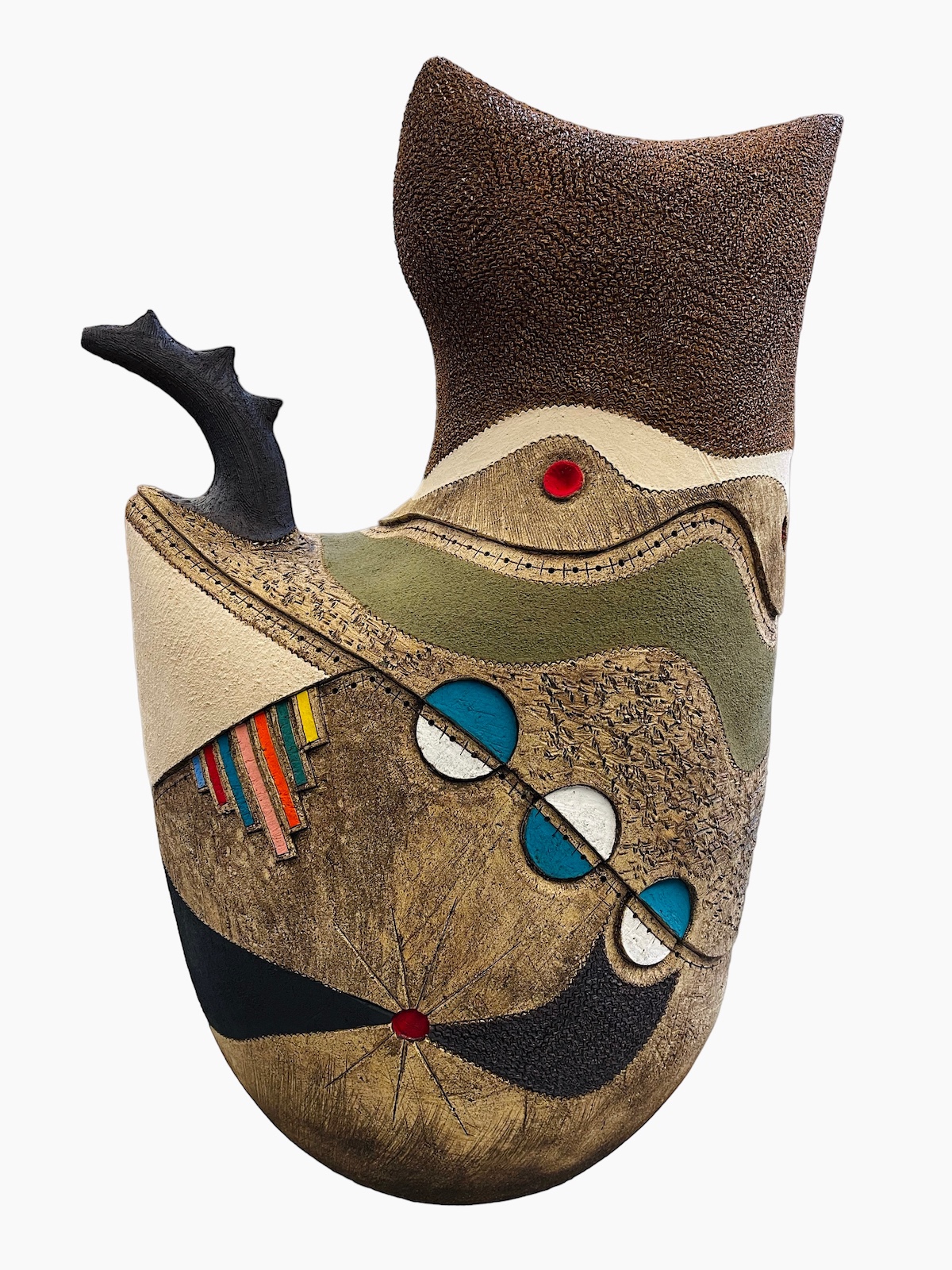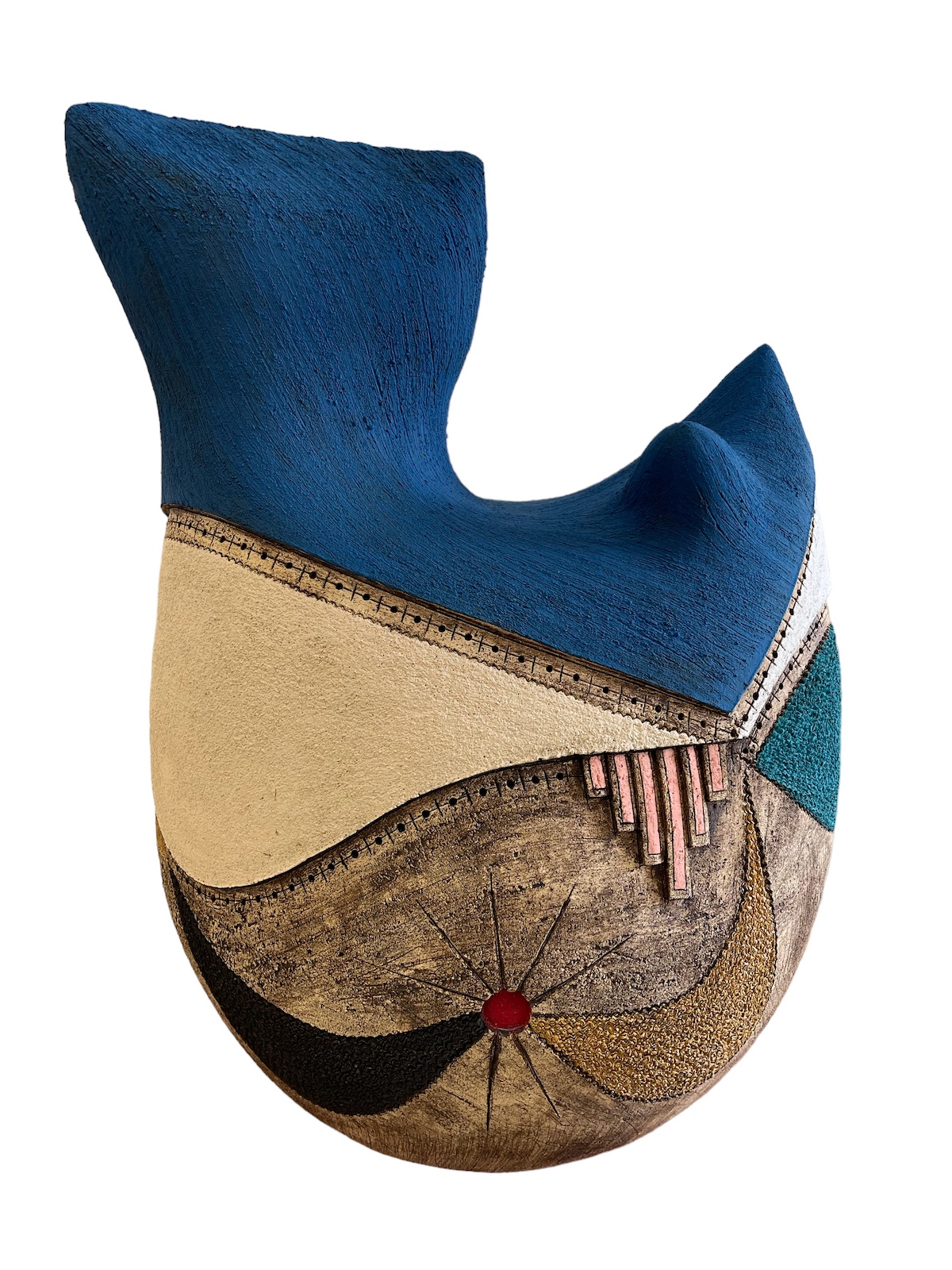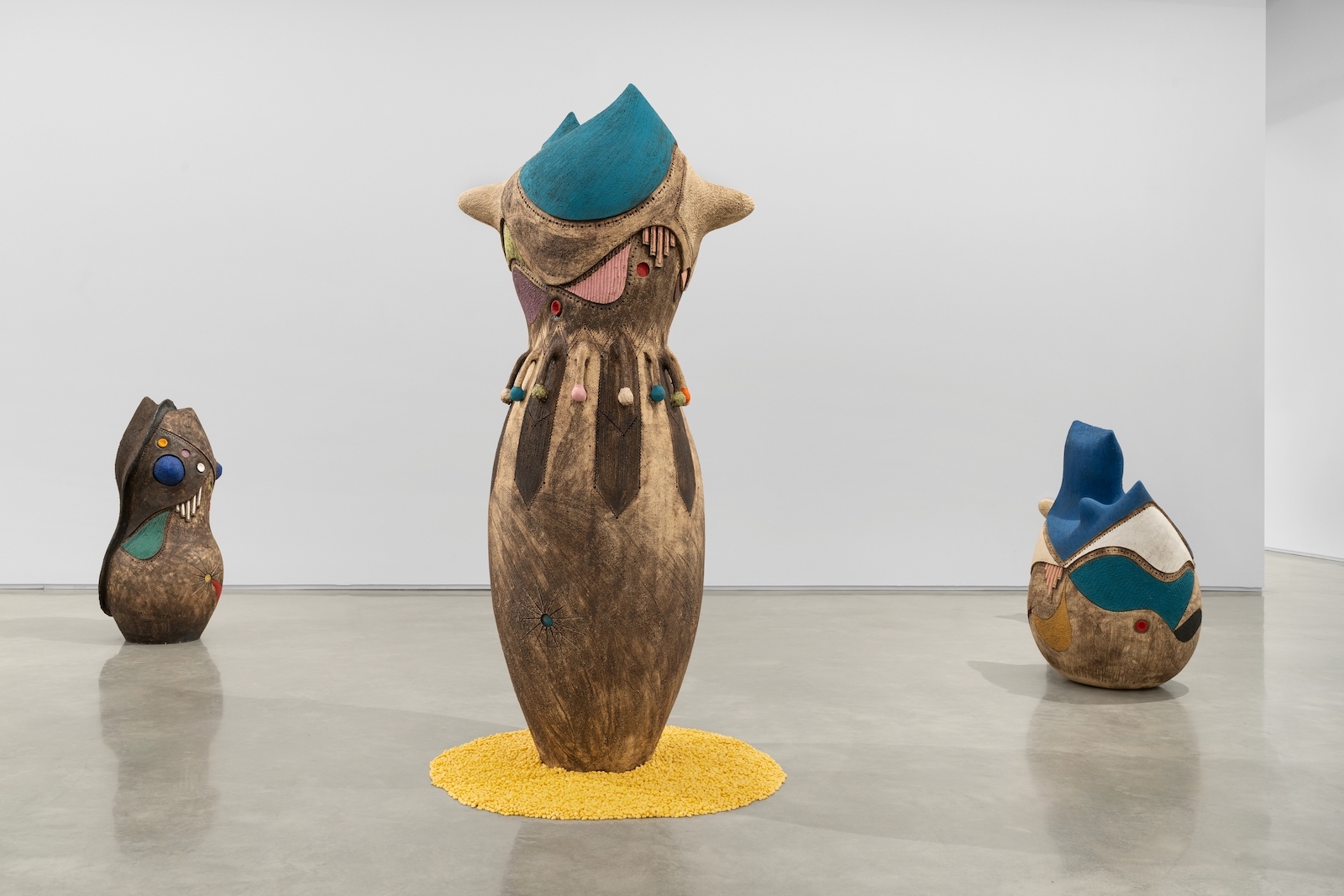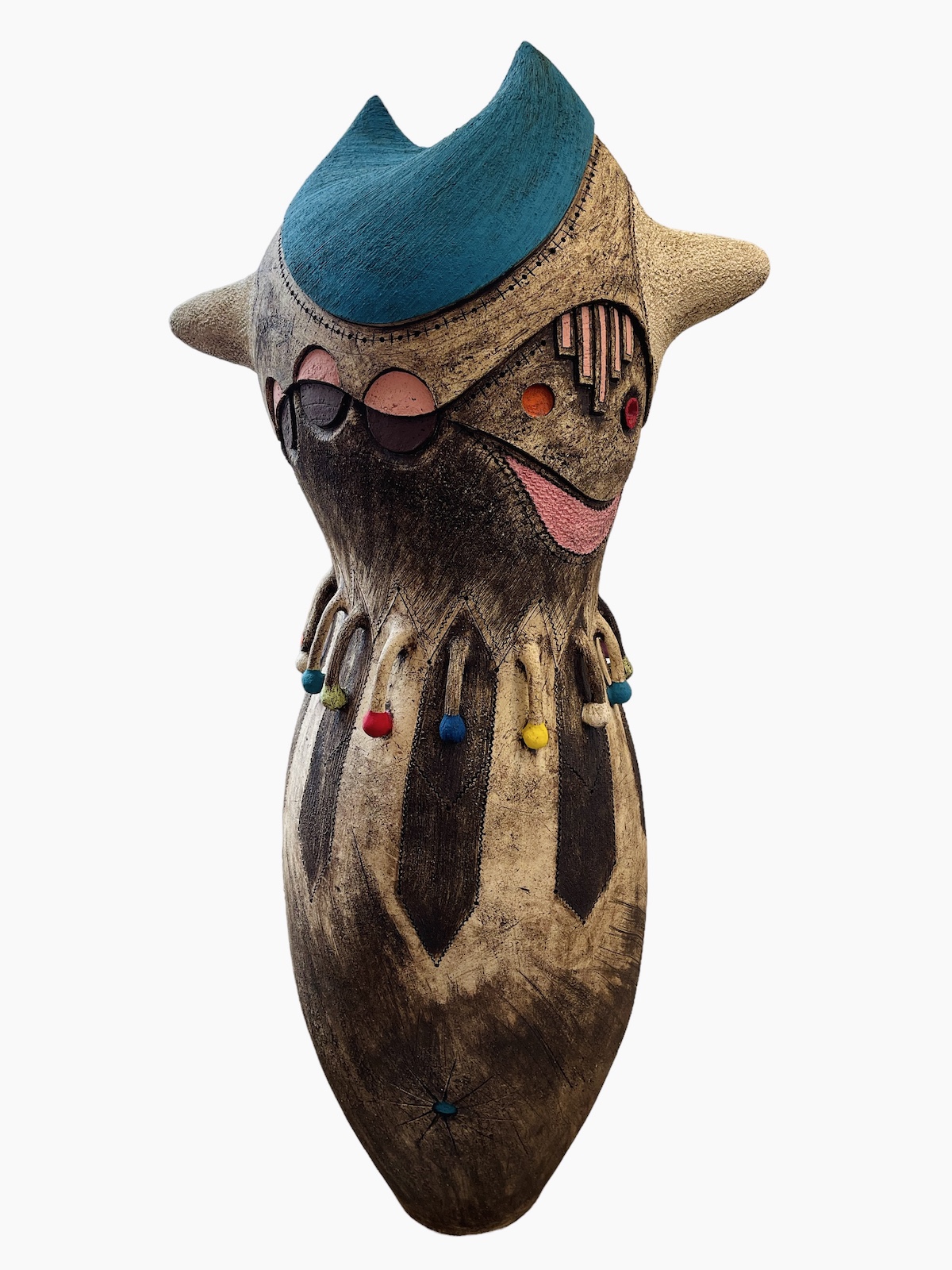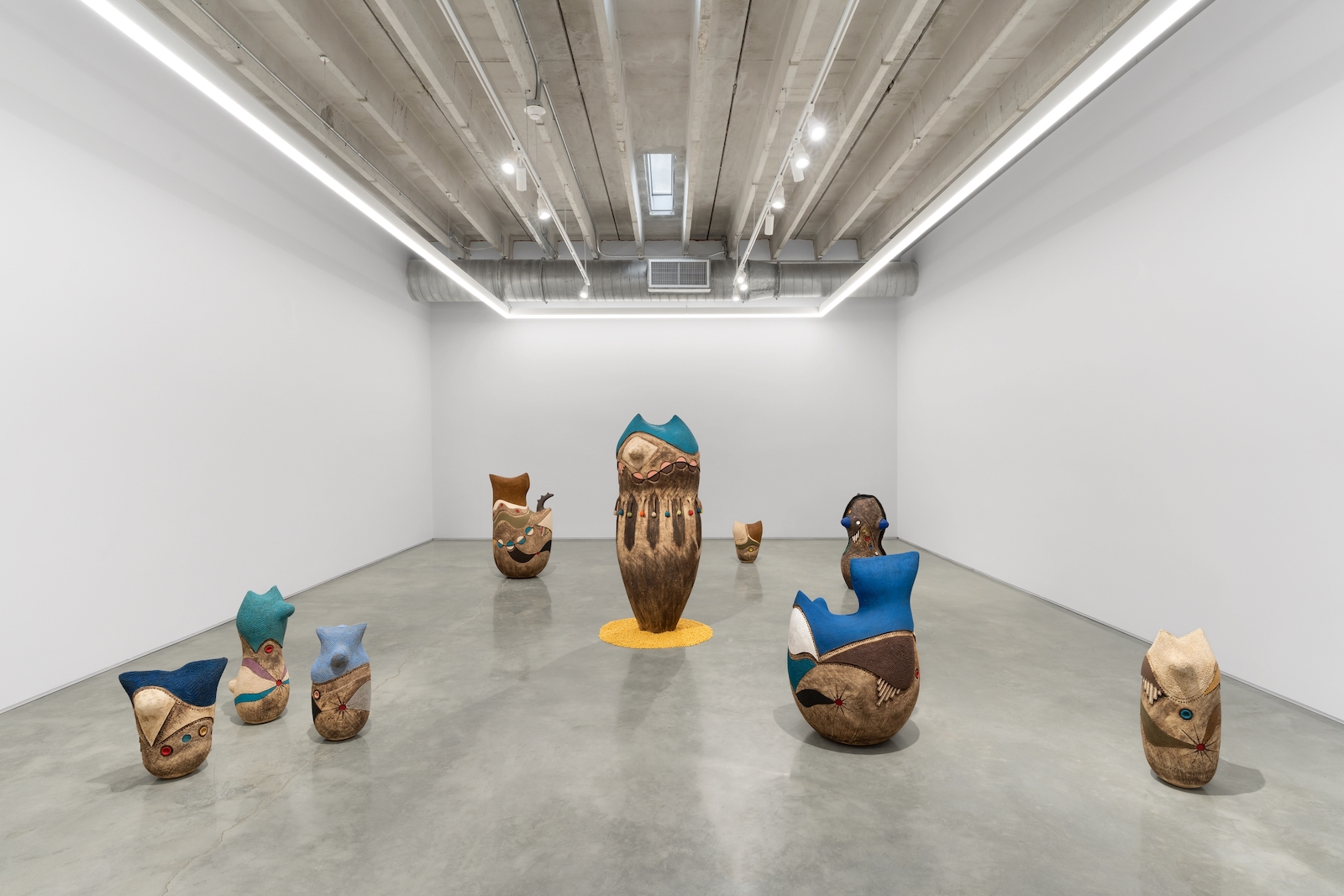Simphiwe Mbunyuza has something to say —
Inkobe, Umnandi Ngo Chubelana
Share:
Touch. Quietude. Play. The haptic constitutes prayer (what we do all the time these days) and longing. We mean to build a fortress inside a swamp. That detonates. The compulsion of tides and fools—play—as the resurrector. Chinua Achebe talked about the Igbo belief in chi—the life force that surrounds us. Chooses us. Protects us. Protects us, as it happens, from ourselves. In my quietude, it is the dreaming.
Ceramicist and dreamer Simphiwe Mbunyuza says that the vessels—the nine objects in his fall 2023 exhibition Inkobe, Umnandi Ngo Chubelana at Mindy Solomon Gallery in Miami—are a means of storytelling. Mbunyuza notes that these stories hold centuries of Xhosa culture and existence, that, in fact, spirits dwell in the vessels—that these vessels are living.
However you name them—vessel or object—they are hyperarticulate forms. Materially graphic forms that become figures. The artist likens the clay pieces to human figures. They are their own being. And certainly sentient. Xhosa iconography is etched into the figures with handwork that rivals molding and whittling. A coiling technique that shrouds its own process. The objects (structures) are hollow, but one might not see them as such, for all their weight. This is clay? This is clay.
Simphiwe Mbunyuza, Isisila se Nkuhu, 2023, ceramic, 41”x27”x21” [photo: Zach Balber Photography; courtesy of the artist and Mindy Solomon Gallery, Miami]
Simphiwe Mbunyuza, Nyoni, 2023, ceramic, 35”x21”x23” [photo:Zach Balber Photography; courtesy of the artist and Mindy Solomon Gallery, Miami]
A communing happens between the viewer and the work, and between the forms themselves. This makes sense. The Chubelana in the exhibition’s title refers to the Xhosa concept of sharing. It’s a figurative expression that best describes communing with one another. The necessity of connection—feeling. The knobbing on the forms, on each of the objects, connotes not just protrusions of a “female” form, but also metamorphosis—a transfiguring of vessel to ledge. Air to twig. The incalculability of landscape on the Eastern Cape. Even the littlest of the objects, the living vessels, is a giant. A directive, “Giant, migrate form.” Sensibility. Eucharist abated. The imprint of Mbunyuza stretching, pulling, and cuffing each section of the form—the action of ridding clay—might better enunciate the task of soil. Maybe to vacate space. The slate spreading, there is the heirloom of ore, in the vernacular of geology. Science slipped—the tiny dilly balls of clay show math at work, x squared plus z divided by that footprint. A casual nod to the physics of spectrum, or where Puryear might’ve entered the room. Approximately death defying. Corners invade themselves. The objects are a rubric for correlating the interior. And for gorging. These are corpulent figures in full bloom. In the mind. In the head. The viewer can know what a rind does—cover, consume, carry. The transmission, please, is about calcifying. In blue. In black.
Simphiwe Mbunyuza, Inkobe, Umnandi Ngo Chubelana installation view, 2023 [photo: Zach
Balber Photography; courtesy of Mindy Solomon Gallery, Miami]
The nine works in the exhibition were positioned in a “come to” circle. They’re very nearly circling. The central and largest form sits atop a disc of artificial corn. Gallery owner Mindy Solomon explained that there had been real kernels of corn in the gallery “until the boll weevils came out to play.” The stand-in corn is an apt replacement in response to a nuisance of organisms beyond one’s control.
There is no wall text other than the artist’s name and title of the show—untranslated from the Xhosa— Inkobe, Umnandi Ngo Chubelana. I didn’t look up the title for the longest time. Even after the gallerist told me, when I first saw the show, that it was “something about sharing.” Standing at a certain angle to the tallest work, I thought to myself where two rivers meet must be what the title means. Mbunyuza’s mind at work, and at play, is a conveyance of water. A dalliance with worship. His inquisitiveness gets to the heart and steel of abstraction. A mark can instruct, obstruct. Deconstruct. Further situate Miró and Klee. The caboose on the largest form, I suppose, is tucked.
Simphiwe Mbunyuza, Mamvulane, 2023, ceramic, 62”x30”x30” [photo: Zach Balber Photography; courtesy of the artist and Mindy Solomon Gallery, Miami]
Or there’s something in the use of colored holes, indentations carefully placed, that get the pupils dilating. Abstraction is where the body and head meet, make nice, and flourish. I’m going to call this a “Leontyne Price-ing thing”—one way of coming back to Mbunyuza’s coiling process. Clear and melodious, still, even when pushed to stirring. I can make sense of it in how the lavender looks rubbed-on or how the green—lime green—looks sloughed off. I was just thinking, then, who’s the hollowed-out drum drumming? I was also thinking about those knobs on the object, those armaments, or protruding bursts of life—something ample. I was realizing that I have the urge to put them in my mouth. I won’t. But I’m grateful the artist hadn’t been negligent of this insistent fused life.
Simphiwe Mbunyuza, Inkobe, Umnandi Ngo Chubelana installation view, 2023 [photo: Zach Balber Photography; courtesy of Mindy Solomon Gallery, Miami]
Sherae Rimpsey is an artist and writer. Rimpsey is the Mildred Thompson Art Writing and Editorial Fellow.
The Mildred Thompson Arts Writing and Editorial Fellowship is a collaboration between Art Papers and Newcomb Art Museum at Tulane University. Funding for the two-year editorial position was provided to Newcomb Art Museum by the Andrew W. Mellon Foundation for an emerging Black arts writer/editor to gain hands-on experience as part of Art Papers’ editorial team. The fellowship also honors and builds upon the legacy of Mildred Thompson, associate editor of ART PAPERS from 1989 to 1997.
Conceptualized as part of Art Papers’ Diversity, Equity, Inclusion, and Accessibility efforts, the fellowship received seed funding from AEC Trust and The Homestead Foundation to pilot the program in 2022.
